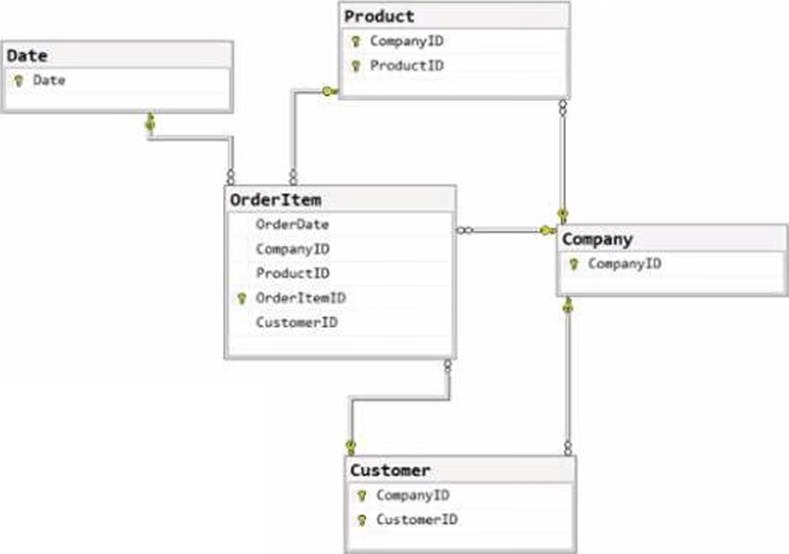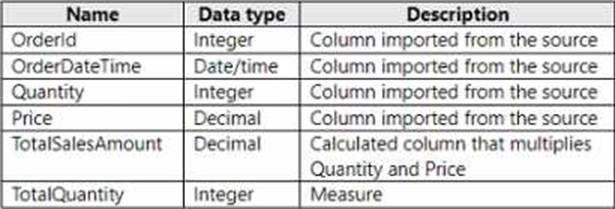Microsoft DP-600 Microsoft Fabric Analytics Engineer Online Training
Microsoft DP-600 Online Training
The questions for DP-600 were last updated at Apr 03,2025.
- Exam Code: DP-600
- Exam Name: Microsoft Fabric Analytics Engineer
- Certification Provider: Microsoft
- Latest update: Apr 03,2025
HOTSPOT
You have a Fabric tenant that contains a warehouse named Warehouse1. Warehouse1 contains three schemas named schemaA, schemaB. and schemaC
You need to ensure that a user named User1 can truncate tables in schemaA only.
How should you complete the T-SQL statement? To answer, select the appropriate options in the answer area. NOTE: Each correct selection is worth one point.

You need to provide Power Bl developers with access to the pipeline.
The solution must meet the following requirements:
• Ensure that the developers can deploy items to the workspaces for Development and Test.
• Prevent the developers from deploying items to the workspace for Production.
• Follow the principle of least privilege.
Which three levels of access should you assign to the developers? Each correct answer presents part of the solution. NOTE: Each correct answer is worth one point.
- A . Build permission to the production semantic models
- B . Admin access to the deployment pipeline
- C . Viewer access to the Development and Test workspaces
- D . Viewer access to the Production workspace
- E . Contributor access to the Development and Test workspaces
- F . Contributor access to the Production workspace
You have a Fabric workspace that contains a DirectQuery semantic model. The model queries a data
source that has 500 million rows.
You have a Microsoft Power Bl report named Report1 that uses the model. Report! contains visuals on multiple pages.
You need to reduce the query execution time for the visuals on all the pages.
What are two features that you can use? Each correct answer presents a complete solution. NOTE: Each correct answer is worth one point.
- A . user-defined aggregations
- B . automatic aggregation
- C . query caching
- D . OneLake integration
You have a Fabric tenant that contains 30 CSV files in OneLake. The files are updated daily.
You create a Microsoft Power Bl semantic model named Modell that uses the CSV files as a data source. You configure incremental refresh for Model 1 and publish the model to a Premium capacity in the Fabric tenant.
When you initiate a refresh of Model1, the refresh fails after running out of resources.
What is a possible cause of the failure?
- A . Query folding is occurring.
- B . Only refresh complete days is selected.
- C . XMLA Endpoint is set to Read Only.
- D . Query folding is NOT occurring.
- E . The data type of the column used to partition the data has changed.
You have a Fabric tenant that uses a Microsoft tower Bl Premium capacity. You need to enable scale-out for a semantic model.
What should you do first?
- A . At the semantic model level, set Large dataset storage format to Off.
- B . At the tenant level, set Create and use Metrics to Enabled.
- C . At the semantic model level, set Large dataset storage format to On.
- D . At the tenant level, set Data Activator to Enabled.
You have a Fabric tenant that contains a warehouse. The warehouse uses row-level security (RLS). You create a Direct Lake semantic model that uses the Delta tables and RLS of the warehouse.
When users interact with a report built from the model, which mode will be used by the DAX queries?
- A . DirectQuery
- B . Dual
- C . Direct Lake
- D . Import
You have a Fabric tenant that contains a complex semantic model. The model is based on a star schema and contains many tables, including a fact table named Sales. You need to create a diagram of the model. The diagram must contain only the Sales table and related tables.
What should you use from Microsoft Power Bl Desktop?
- A . data categories
- B . Data view
- C . Model view
- D . DAX query view
You have a Fabric tenant that contains a semantic model. The model uses Direct Lake mode.
You suspect that some DAX queries load unnecessary columns into memory.
You need to identify the frequently used columns that are loaded into memory.
What are two ways to achieve the goal? Each correct answer presents a complete solution. NOTE: Each correct answer is worth one point.
- A . Use the Analyze in Excel feature.
- B . Use the Vertipaq Analyzer tool.
- C . Query the $system.discovered_STORAGE_TABLE_COLUMN-iN_SEGMeNTS dynamic management view (DMV).
- D . Query the discover_hehory6Rant dynamic management view (DMV).
HOTSPOT
You have the source data model shown in the following exhibit.

The primary keys of the tables are indicated by a key symbol beside the columns involved in each key.
You need to create a dimensional data model that will enable the analysis of order items by date, product, and customer.
What should you include in the solution? To answer, select the appropriate options in the answer
area. NOTE: Each correct selection is worth one point.

You have a Fabric tenant that contains a semantic model named Model1. Model1 uses Import mode.
Model1 contains a table named Orders.
Orders has 100 million rows and the following fields.

You need to reduce the memory used by Model! and the time it takes to refresh the model.
Which two actions should you perform? Each correct answer presents part of the solution. NOTE: Each correct answer is worth one point.
- A . Split OrderDateTime into separate date and time columns.
- B . Replace TotalQuantity with a calculated column.
- C . Convert Quantity into the Text data type.
- D . Replace TotalSalesAmount with a measure.
Latest DP-600 Dumps Valid Version with 55 Q&As
Latest And Valid Q&A | Instant Download | Once Fail, Full Refund



